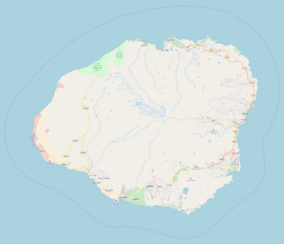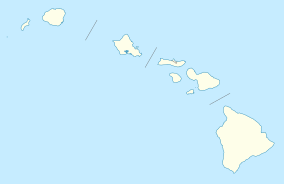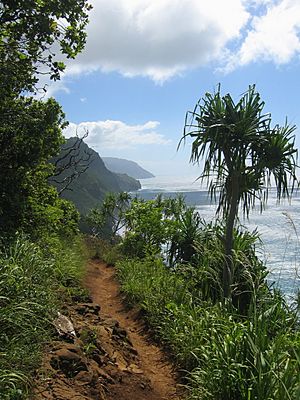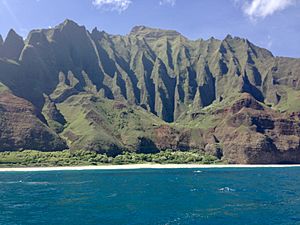Nā Pali Coast State Park facts for kids
Quick facts for kids Nā Pali Coast State Park |
|
|---|---|
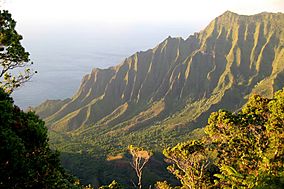
Nā Pali overlook of the Kalalau Valley
|
|
| Location | Kauaʻi, United States |
| Area | 6,175 acres (24.99 km2) |
| Governing body | Hawaii Department of Land and Natural Resources |

Nā Pali Coast State Park is a beautiful state park in Hawaii. It covers over 6,000 acres (about 2,500 hectares). This park is on the northwest side of Kauaʻi. Kauaʻi is the oldest inhabited Hawaiian island.
The name Nā Pali means "the high cliffs" in Hawaiian. These amazing cliffs rise up to 4,000 feet (about 1,200 meters) from the Pacific Ocean. The park was created to protect the stunning Kalalau Valley.
Right next to the state park is the Hono O Nā Pali State Natural Reserve. This reserve was started in 1983. It helps protect even more of this special area.
Contents
Visiting Nā Pali Coast
You cannot drive a car into Nā Pali Coast State Park. But there are many exciting ways to see it! You can go hiking on land. You can also see the coast from above in a helicopter.
From the ocean, you can explore by kayak or paddleboard. Many boat tours also leave from Port Allen and Hanalei Bay. These tours use special boats like rigid-hulled inflatables or catamarans.
The Kalalau Trail
The Kalalau Trail is the only way to walk along the coast. It starts at the end of Hawaii Route 56. This trail is 11 miles (about 18 kilometers) long. It goes through five big valleys and many smaller ones. The trail ends at Kalalau Beach. Along the way, smaller paths lead to beautiful waterfalls.
History of the Coast
The first people to live on the Nā Pali Coast were Polynesian navigators. They arrived around 1200 AD. Later, many people from Tahiti also came. They helped shape the culture of Kauaʻi and other Hawaiian islands.
The coast was an important place for trading goods. People traded between Hanalei, Waimea, and Ni`ihau. In 1778, Captain Cook visited Kauaʻi. After his visit, more Westerners came to the island. Sadly, many native Hawaiians living along the Nā Pali Coast became sick from new diseases. The last native Hawaiians known to live here were seen in the 1900s.
Camping in the Park
If you want to camp in Nā Pali Coast State Park, you need a special permit. There are three places where you can camp.
During the summer (May 15 to September 7), you can only reach some campsites by boat or kayak. You still need a permit for this.
Camping on the Kalalau Trail
Along the Kalalau Trail, there are two official camping spots:
- Kalalau
- Hanakoa
You can reach both by hiking. The same permit covers both locations. These spots have facilities for campers. You can stay a maximum of five nights on the Kalalau Trail. For Hanakoa, you can stay one night.
Miloli'i Campsite
The campsite at Miloli'i can only be reached by boat or kayak. Permits for Miloli'i allow you to stay for a maximum of three days. All three camping sites have composting toilets.
Images for kids
See also
 In Spanish: Parque estatal Costa de Nā Pali para niños
In Spanish: Parque estatal Costa de Nā Pali para niños


